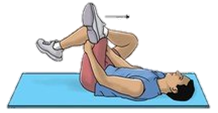A bursa is a small sack of fluid which is usually positioned in between a bone and a muscle or tendon. The function of a bursa is to prevent friction between the bone and overlying soft tissue.
There are several bursas around the hip joint, but the most common type of hip bursitis is from the trochanteric bursa.
Trochanteric bursa – on the outside of the hip between the greater trochanter and the attachments of the gluteal muscles.
Causes
It can be caused by one of two ways, through a direct impact to the bursa, such as a fall onto the outer hip, which is known as traumatic bursitis, or through repetitive friction from the overlying muscles and tendons, usually during running.
This repeated friction results in the bursa becoming inflamed and swollen. Every time the tendons then rub over the bursa, this causes pain.
Most cases of bursitis are overuse injuries due to biomechanical abnormalities. If you overpronate then you are more susceptible to this injury as the knee falls inwards which increases the angle at the hip.
Weakness in the glutes has the same effect along side tight structures surrounding the hip such as the iliotibial band, hip flexors, and hamstrings.
A bone spur which is a small excess growth of bone which can aggravate the bursa.
Treatment
Rest until there is no pain. Continuing to train will increase the inflammation and prevent hip bursitis from healing.
Apply ice to the area to reduce pain and inflammation. Cold can be applied for 10 minutes every hour and reduced to 3 or 4 times a day as the injury heals.
Run only on flat, even surfaces to reduce the pressure on the bursa from uneven ground.
physical therapy to correct any muscle imbalances which may have contributed to the condition.
A needle can be inserted into the bursa to drain off the fluid or aspirate it.
Steroid injections may be prescribed in conjunction with rest.
A surgeon may operate if it is a long term injury which has not responded to conservative treatment.
Prevention Exercises
If muscles surrounding the hip joint are tight then these must be stretched to reduce pressure on the bursa.
Stretches for the outer hip, gluteal muscles, hip flexors, and hamstrings are important.
Strengthening exercises more commonly need to be done for the muscles on the outside of the hip rather than the adductor muscles or hamstrings.
The aim of rehabilitation of hip bursitis is to reduce pain and inflammation on the hip, identify possible causes and return to full fitness.






Contact Me
Let's chat!
Need more information? Send me an email or drop me a line. I don’t bite!
- Charlotte@rehabontheroad.co.uk
- 07971448719
